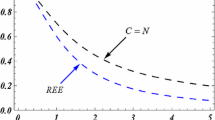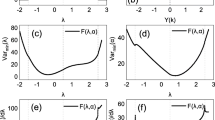Abstract
Quantum phase transition is primarily characterized by a qualitative sudden change in the ground state of a quantum system when an external or internal parameter of the Hamiltonian is continuously varied. Investigating quantum criticality using information-theoretic methods has generated fruitful results. Quantum correlations and fidelity have been exploited to characterize the quantum critical phenomena. In this work, we employ quantum Fisher information to study quantum criticality. The singular or extremal point of the quantum Fisher information is adopted as the estimated thermal critical point. By a significant model constructed in Quan et al. (Phys Rev Lett 96: 140604, 2006), the effectiveness of this method is illustrated explicitly.




Similar content being viewed by others
References
Sachdev, S.: Quantum Phase Transitions. Cambridge University Press, Cambridge (1999)
Shankar, R.: Renormalization-group approach to interacting Fermions. Rev. Mod. Phys. 66, 129 (1994)
Landau, D.P., Binder, K.: A Guide to Monte Carlo Simulations in Statistical Physics. Cambridge University Press, Cambridge (2006)
Yuan, Z.-G., Zhang, P., Li, S.-S.: Disentanglement of two qubits coupled to an XY spin chain: role of quantum phase transition. Phys. Rev. A 76, 042118 (2007)
Liu, B.-Q., Shao, B., Zou, J.: Quantum discord for a central two-qubit system coupled to an XY-spin-chain environment. Phys. Rev. A 82, 062119 (2010)
Qiu, L., Tang, G., Han, K., Yang, X.Q., Wu, Y.X., Ye, B.: Quantum discord for a central two-qubit system coupled to an XY spin chain with multipartite interaction. Physica E 46, 218–223 (2012)
Osborne, T.J., Nielsen, M.A.: Entanglement in a simple quantum phase transition. Phys. Rev. A 66, 032110 (2002)
Wu, L.-A., Sarandy, M.S., Lidar, D.A.: Quantum phase transitions and bipartite entanglement. Phys. Rev. Lett. 93, 250404 (2004)
Altintas, F., Eryigit, R.: Correlations and nonlocality measures as indicators of quantum phase transitions in several critical systems. Ann. Phys. 327, 3084 (2012)
Gu, S.-J., Sun, C.-P., Lin, H.-Q.: Universal role of correlation entropy in critical phenomena. J. Phys. A 41, 025002 (2008)
Werlang, T., Trippe, C., Ribeiro, G.A.P., Rigolin, G.: Quantum correlations in spin chains at finite temperatures and quantum phase transitions. Phys. Rev. Lett. 105, 095702 (2010)
Werlang, T., Ribeiro, G.A.P., Rigolin, G.: Spotlighting quantum critical points via quantum correlations at finite temperatures. Phys. Rev. A 83, 062334 (2011)
Li, Y.C., Lin, H.Q.: Thermal quantum and classical correlations and entanglement in the XY spin model with three-spin interaction. Phys. Rev. A 83, 052323 (2011)
Çakmak, B., Karpat, G., Gedik, Z.: Critical point estimation and long-range behavior in the one-dimensional XY model using thermal quantum and total correlations. Phys. Lett. A 376, 2982 (2012)
Maziero, J., Céleri, L.C., Serra, R.M., Sarandy, M.S.: Long-range quantum discord in critical spin systems. Phys. Lett. A 376, 1540 (2012)
Campbell, S., Richens, J., Gullo, N.L., Busch, T.: Criticality, factorization, and long-range correlations in the anisotropic XY model. Phys. Rev. A 88, 062305 (2013)
Ollivier, H., Zurek, W.H.: Quantum discord: a measure of the quantumness of correlations. Phys. Rev. Lett. 88, 017901 (2001)
Henderson, L., Vedral, V.: Classical, quantum and total correlations. J. Phys. A 34, 6899 (2001)
Luo, S.: Quantum discord for two-qubit systems. Phys. Rev. A 77, 042303 (2008)
Luo, S.: Using measurement-induced disturbance to characterize correlations as classical or quantum. Phys. Rev. A 77, 022301 (2008)
Dillenschneider, R.: Quantum discord and quantum phase transition in spin chains. Phys. Rev. B 78, 224413 (2008)
Sarandy, M.S.: Classical correlation and quantum discord in critical systems. Phys. Rev. A 80, 022108 (2009)
Maziero, J., Guzman, H.C., Céleri, L.C., Sarandy, M.S., Serra, R.M.: Quantum and classical thermal correlations in the XY spin-1/2 chain. Phys. Rev. A 82, 012106 (2010)
Quan, H.T., Song, Z., Liu, X.F., Zanardi, P., Sun, C.P.: Decay of Loschmidt echo enhanced by quantum criticality. Phys. Rev. Lett. 96, 140604 (2006)
Zanardi, P., Quan, H.T., Wang, X., Sun, C.P.: Mixed-state fidelity and quantum criticality at finite temperature. Phys. Rev. A 75, 032109 (2007)
Lu, X.-M., Sun, Z., Wang, X., Zanardi, P.: Operator fidelity susceptibility, decoherence, quantum criticality. Phys. Rev. A 78, 032309 (2008)
Kwok, H.-M., Ning, W.-Q., Gu, S.-J., Lin, H.-Q.: Quantum criticality of the Lipkin-Meshkov-Glick model in terms of fidelity susceptibility. Phys. Rev. E 78, 032103 (2008)
Gu, S.-J.: Fidelity approach to quantum phase transitions. Int. J. Mod. Phys. B 24, 4371 (2010)
Yuen, H.P., Lax, M.: Multi-parameter quantum estimation and measurement of nonselfadjoint observables. IEEE Trans. Inf. Theory 19, 740 (1973)
Helstrom, C.W.: Quantum Detection and Estimation Theory. Academic Press, New York (1976)
Holevo, A.S.: Probabilistic and Statistical Aspects of Quantum Theory. North-Holland Publishing Company, Amsterdam (1982)
Wootters, W.K.: Statistical distance and Hilbert space. Phys. Rev. D 23, 357 (1981)
Braunstein, S.L., Caves, C.M.: Statistical distance and the geometry of quantum states. Phys. Rev. Lett. 72, 3439 (1994)
Fujiwara, A., Nagaoka, H.: Quantum Fisher metric and estimation for pure state models. Phys. Lett. A 201, 119 (1995)
Petz, D.: Monotone metrics on matrix spaces. Linear Algebra Appl. 244, 81 (1996)
Barndorff-Nielsen, O.E., Gill, R.D.: Fisher information in quantum statistics. J. Phys. A 33, 4481 (2000)
Luo, S.: Wigner-Yanase skew information vs. quantum Fisher information. Proc. Am. Math. Soc. 132, 885 (2004)
Paris, M.G.A., Řeháček, J.: Quantum State Estimation. Springer, Heidelberg (2004)
Giovannetti, V., Lloyd, S., Maccone, L.: Quantum metrology. Phys. Rev. Lett. 96, 010401 (2006)
Paris, M.G.A.: Quantum estimation for quantum technology. Int. J. Quantum Inform. 7, 125 (2009)
Chen, P., Luo, S.: Clocks and Fisher information. Theor. Math. Phys. 165, 1552 (2010)
Genoni, M.G., Olivares, S., Paris, M.G.A.: Optical phase estimation in the presence of phase diffusion. Phys. Rev. Lett. 106, 153603 (2011)
Giovannetti, V., Lloyd, S., Maccone, L.: Advances in quantum metrology. Nat. Photonics 5, 222 (2011)
Escher, B.M., de Matos Filho, R.L., Davidovich, L.: General framework for estimating the ultimate precision limit in noisy quantum-enhanced metrology. Nat. Phys. 7, 406 (2011)
Lu, X.-M., Luo, S., Oh, C.H.: Hierarchy of measurement-induced Fisher information for composite states. Phys. Rev. A 86, 022342 (2012)
Bera, M.N.: Quantum Fisher information as the measure of Gaussian quantum correlation: Role in quantum metrology. arXiv:1406.5144 (2014)
Strobel, H., Muessel, W., Linnemann, D., Zibold, T., Hume, D.B., Pezzè, L., Smerzi, A., Oberthaler, M.K.: Fisher information and entanglement of non-Gaussian spin states. Science 345(6195), 424–427 (2014)
Hyllus, P., Pezzè, L., Smerzi, A.: Entanglement and sensitivity in precision measurements with states of a fluctuating number of particles. Phys. Rev. Lett. 105, 120501 (2010)
Hyllus, P., Laskowski, W., Krsichek, R., Schwemmer, C., Wieczork, W., Weinfurter, H., Pezzè, L., Smerzi, A.: Fisher information and multiparticle entanglement. Phys. Rev. A 85, 022321 (2012)
Ma, J., Wang, X.: Fisher information and spin squeezing in the Lipkin–Meshkov–Glick model. Phys. Rev. A 80, 012318 (2009)
Sun, Z., Ma, J., Lu, X.-M., Wang, X.: Fisher information in a quantum-critical environment. Phys. Rev. A 82, 022306 (2010)
Wang, T.-L., Wu, L.-N., Yang, W., Jin, G.-R., Lambert, N., Nori, F.: Quantum Fisher information as a signature of the superradiant quantum phase transition. New J. Phys. 16, 063039 (2014)
Nielsen, M., Chuang, I.: Quantum Computation and Quantum Information. Cambridge University Press, Cambridge (2000)
Bures, D.: An extension of Kakutani’s theorem on infinite product measures to the tensor product of semifinite w*-algebras. Trans. Am. Math. Soc. 135, 199 (1969)
Uhlmann, A.: The transition probability in the state space of a *-algebra. Rep. Math. Phys. 9, 273 (1976)
Song, H., Luo, S., Hong, Y.: Quantum non-Markovianity based on the Fisher-information matrix. Phys. Rev. A 91, 042110 (2015)
Hong, Y., Luo, S., Song, H.: Detecting k-nonseparability via quantum Fisher information. Phys. Rev. A 91, 042313 (2015)
Lu, X.-M., Yu, S., Oh, C.H.: Robust quantum metrological schemes based on protection of quantum Fisher information. Nat. Commun. 6, 7282 (2015)
Hepp, K.: Quantum theory of measurement and macroscopic observables. Helv. Phys. Acta 45, 237 (1972)
Bell, J.S.: On wave packet reduction in the coleman–Hepp model. Helv. Phys. Acta 48, 93 (1975)
Author information
Authors and Affiliations
Corresponding author
Additional information
This work was supported by the National Natural Science Foundation of China, Grants No.11375259, No.11605284, and No.61134008, the National Center for Mathematics and Interdisciplinary Sciences, CAS, Grant No. Y029152K51, and the Fundamental Research Funds for the Central Universities, FRF-TP-16-010A1.
Appendix
Appendix
Here, we present detailed derivation of Eq. (2). For the state \(\rho _S(t)\) in Eq. (1), the explicit expression of the symmetric logarithmic derivatives \(L_\lambda \) determined by
is given by
with
The quantum Fisher information \(F_\lambda (t)\) can be evaluated as
where \(L(\lambda )=|f(\lambda )|^2\). It remains to evaluate explicitly \(f(\lambda ),\) which is the main difficult task.
Following the method in Ref. [24], the Hamiltonian \(H(\lambda ,\delta )\) can be rewritten in a diagonal form as
with \(\varepsilon _e^k=2J\sqrt{1+(\lambda +\delta )^2-2(\lambda +\delta )\cos (ka)}\) being the single quasiexcitation energy and
being the normal mode operators which satisfy the canonical Fermion anticommunication relations. Here, \(u_e^k=\cos (\theta _e^k/2)\) and \(v_e^k=\sin (\theta _e^k/2)\) with
The operator \(\sigma _l^{[\pm ]}=(-\sigma _l^z\pm i\sigma _l^y)/2\) is defined by the Pauli matrices acting on the lth site of the spin chain.
Similarly (or by putting \(\delta =0\)), the Hamiltonian \(H(\lambda ,0)\) can be diagonalized as
with \(\varepsilon _g^k=2J\sqrt{1+\lambda ^2-2\lambda \cos (ka)}\) and
Here, \(u_g^k=\cos (\theta _g^k/2)\), \(v_g^k=\sin (\theta _g^k/2)\), and \(\theta _g^k=\arctan \frac{\sin (ka)}{\lambda -\cos (ka)}.\)
The Fermionic quasiexcitation operators \(B_k\) can be verified to be related with the operators \(A_k\) by the following Bogoliubov transformation
where \(\alpha _k=(\theta _g^k-\theta _e^k)/2\).
Suppose the Ising spin chain in a transverse field depicted by \(H( \lambda ,0)\) is initially in the ground state \(|\varphi (0)\rangle =|G\rangle \) which can be rewritten as
where \(|E\rangle \) is the ground state of \(H(\lambda ,\delta )\), then the expression of \(f(\lambda )\) can be calculated as
Since \(B_k|G\rangle =0\), \([A_k^\dagger A_k, A_j^\dagger A_j]=0\), and \((A_k^\dagger A_k)^n=A_k^\dagger A_k\) for any positive integer n, the above expression turns out to be
By virtue of the equations
where we have used \(\varepsilon _e^{-l}=\varepsilon _e^{l}\) in the second equality,
and for all \(m>l\ge 0\),
the expression can be further simplified as
Finally, using
and \(A_k|E\rangle =0\) for all k, we get
Furthermore, it is worth mentioning that the explicit expression of Loschmidt echo \(L(\lambda )\) can be directly derived from \(f(\lambda )\). Specifically,
which is in accordance with the result in Ref. [24].
Rights and permissions
About this article
Cite this article
Song, H., Luo, S. & Fu, S. Quantum criticality from Fisher information. Quantum Inf Process 16, 91 (2017). https://doi.org/10.1007/s11128-017-1543-9
Received:
Accepted:
Published:
DOI: https://doi.org/10.1007/s11128-017-1543-9




